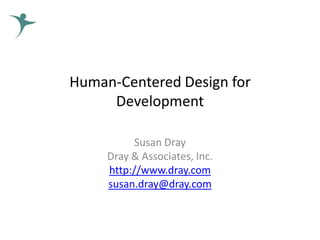Human-Centered Design for Development (HCD4D): Workshop at U(X)PA2012
- 1. Human-Centered Design for Development Susan Dray Dray & Associates, Inc. http://www.dray.com susan.dray@dray.com
- 2. Human-Centered Design for Development (HCD4D) • Introductions • What’s it like in the “developing” world? • A brief history of HCD4D • Sharing experiences • What do we want to tell UXPA about this (and how?)
- 3. Who Am I? • First international ethnographic study in 1994 • Work in 24 countries since then – On every continent except Antarctica • Involved in multiple overlapping professional communities – UPA, SIGCHI, HFES, etc. • Intense personal interest in “making a difference” • Getting more and more involved in Human-Centered Design For Development (HCD4D) community
- 4. What’s it like for the urban poor in the “Developing” World?* *Caveat: These are not universal; conditions vary widely
- 5. Poor (or lacking) infrastructure
- 7. No sanitary facilities or Shared sanitation (pit latrines)
- 8. No indoor water (Must bring from communal tap)
- 10. Washing and bathing outside (Must heat water on stove)
- 11. Informal markets
- 12. Open-air markets with no refrigeration
- 13. Crime
- 14. Electricity – not always available (May be pirated or prepaid)
- 15. Cell phones Phone kiosks in containers
- 17. Public transport
- 19. Animal-powered rather than motor-powered
- 20. Human-powered
- 21. Other characteristics • Lack of access to adequate healthcare • Illiteracy or partial literacy • Poor schools • High levels of unemployment, especially among youth (many of whom have dropped out of school) • Food insecurity • Etc.
- 22. What’s it like for the rural poor in the “Developing” World?* *Caveat: These are not universal; conditions vary widely
- 24. No indoor water (Must bring from water source)
- 25. Water source may be miles away (It’s women’s work to bring it to the home)
- 26. Transport unreliable and infrequent
- 29. Livelihood based on agriculture, little cash
- 30. No indoor stove
- 31. No electricity
- 33. Other characteristics • Lack of access to adequate healthcare • Illiteracy or partial literacy • Children left with grandparents while parents work in cities to send money home • High levels of unemployment, especially among youth (many of whom have dropped out of school) • Food insecurity • Etc.
- 34. A Product Fails • Product concept was a battery-operated device to eliminate odors in refrigerators • Engineers and executives were very excited about it • Positive responses in focus groups • D&A was hired by client to do study of refrigerators to support product development
- 35. Research For Product Development • Ethnographic visits to 12 homes – Focus on “video tour” of fridge – Researcher paid particular attention to odors – both observed and mentioned • No one perceived an odor in their fridge – Even fridges that the researcher found to be stinky • No one thought the proposed product was a good idea either during tour or during post-tour interview – “Why would I spend $30 to put something that uses batteries in my fridge, when I can buy a box of baking soda for 50 cents?”
- 36. Did It Change Anything? • Research was presented to client – Videos of fridge “tours” – Photos of interiors and of people placing the product – Audio clips from interviews – Negative fit and response was “loud and clear” • Response was polite but cool – Thanks a lot – here’s the door
- 37. And Yet… One year later, the project was cancelled having spent over $1 million USD more on it
- 38. A Development Project Fails* • Internationally funded aid project to provide modern concrete dam and canals to Nepalese farmers • Large project with professional design, materials, and construction – Consultation from top engineering firm – State of the art • Despite all this and massive funding, dam did not deliver more water to farmers downstream *As described in Freakonomics Levitt & Dubner, 2009
- 39. What Happened? • Traditionally, irrigation was small dams and crude canals requiring maintenance • Canal maintenance requires clearing obstructions and brush • Traditionally, this work was shared by all farmers • Although the dam did not require maintenance, the distribution canals still did • However, the traditional agreement between upstream and downstream farmers broke down • Farmers near the dam no longer motivated to maintain canals because they got all the water they needed • Therefore, downstream farmers got less water
- 40. What Do These Failures Have In Common?
- 41. Human International Centered HCD4D Economic & Design Community Development
- 42. Early Community-Building • Workshop at CHI 2007 (April, 2007; San Jose, US): UCD4D (1 day) – 50+ participants from 14 countries – NSF grant to cover “developing country” attendees from universities and NGOs (Africa, S. Asia, Asia) • SIG and Panel at INTERACT 2007 (September, 2007; Rio, Brazil) • Workshop at DIS 2008 (February, 2008; Cape Town, South Africa) (2 – 3 days – optional “immersion” day preceding workshop) – Plan to video tape visits and create a documentary for use at CHI • Workshop at CHI 2008 (April, 2008; Florence, Italy): HCI for Community and International Development (2 days)
- 43. For more on the history (and more resources), check out: http://www.dray.com
- 44. Sharing Experiences • Garren • Ben • Michael • Jackie • Ming • Anant • Anat • Narender • Brian • Keita • Ryan • Andy • Kami
- 45. Just Remember To… Keep your heart on your feet (rather than on your sleeve) so they take you in the right direction!













































